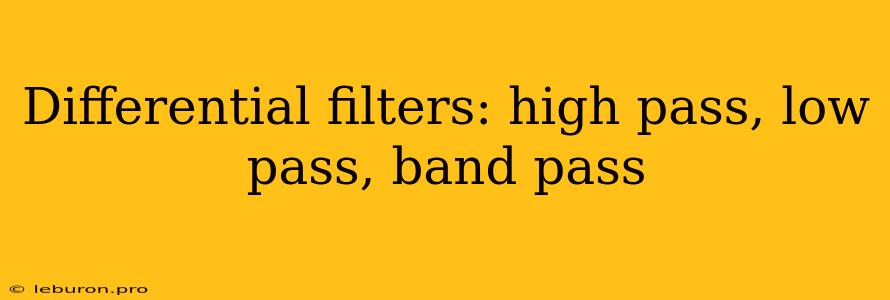Filtering the Noise: Understanding Differential Filters
Differential filters are essential tools in signal processing, enabling us to isolate specific frequency components within a signal. These filters act as selective gates, allowing certain frequencies to pass through while attenuating others. Understanding the different types of differential filters and their applications is crucial for various fields like audio engineering, image processing, and telecommunications.
Types of Differential Filters
There are three primary types of differential filters, each characterized by its unique frequency response:
1. Low-Pass Filters
As the name suggests, low-pass filters allow low-frequency signals to pass through while attenuating high-frequency signals. Imagine a sieve with large holes: small particles pass through, while larger particles are blocked. Similarly, low-pass filters let through the "slow" changes in a signal while filtering out the "fast" changes.
Applications of Low-Pass Filters:
- Audio Engineering: Low-pass filters are used to remove high-frequency noise from audio signals, such as hissing or crackling sounds. They can also be used to create a "warm" sound by emphasizing the low frequencies.
- Image Processing: In image processing, low-pass filters are used to blur images, smoothing out edges and reducing noise. This can be useful for creating artistic effects or enhancing the overall quality of an image.
- Control Systems: Low-pass filters are often used in control systems to smooth out noisy sensor readings, making the system more stable and responsive.
2. High-Pass Filters
High-pass filters perform the opposite function of low-pass filters. They allow high-frequency signals to pass through while attenuating low-frequency signals. In our sieve analogy, high-pass filters are like sieves with small holes, letting only the small particles through.
Applications of High-Pass Filters:
- Audio Engineering: High-pass filters are used to remove low-frequency rumble or hum from audio signals, which can be caused by factors like power lines or vibrations.
- Image Processing: High-pass filters can be used to sharpen images by enhancing edges and details. This is useful for tasks like edge detection in computer vision.
- Medical Imaging: High-pass filters are used in medical imaging to enhance edges and contrast, making it easier to diagnose medical conditions.
3. Band-Pass Filters
Band-pass filters are more selective than low-pass or high-pass filters. They allow a specific range of frequencies to pass through while attenuating frequencies outside that range. Imagine a sieve with holes of a specific size: only particles that fit through these holes can pass.
Applications of Band-Pass Filters:
- Radio Communications: Band-pass filters are essential for radio receivers, allowing them to tune in to specific frequencies while blocking out others.
- Audio Equalization: Band-pass filters are used in audio equalizers to boost or cut specific frequencies, shaping the tonal balance of a sound.
- Medical Equipment: Band-pass filters are used in medical equipment like EKG machines to isolate specific frequency ranges related to heart activity.
Implementing Differential Filters
Differential filters can be implemented in both analog and digital domains. In analog circuits, filters are constructed using resistors, capacitors, and inductors. Digital filters are implemented using software algorithms.
Analog filters:
- RC Filter: A simple low-pass filter can be made using a resistor and capacitor, while a high-pass filter can be made using a capacitor and resistor.
- LC Filter: Inductor-capacitor (LC) filters are used to create more sophisticated filter circuits with higher quality factors and sharper cutoff frequencies.
Digital filters:
- FIR (Finite Impulse Response) Filters: These filters are implemented using a series of multiplications and additions, and are generally considered more computationally efficient.
- IIR (Infinite Impulse Response) Filters: IIR filters are more complex, but can achieve sharper cutoff frequencies with fewer coefficients.
Conclusion
Differential filters play a critical role in shaping and manipulating signals. Understanding the different types of filters and their applications is essential for effectively processing signals in various domains. Whether isolating desired frequencies in audio, enhancing image details, or tuning into radio broadcasts, differential filters remain indispensable tools in modern technology.
